| |||
| Math Central | Quandaries & Queries |
|
Question from R., a parent: Hi If two points of a triangle are fixed, then how can the third point be placed in order to get the smallest possible perimeter of the triangle. Thanks |
Hi,
Fix two vertices A and B to form one side of a triangle. Now choose another point C not on the line joining A and B and construct the triangle ABC. I can then construct a triangle ABD with a smaller perimeter than your triangle by placing D half way between A and C.
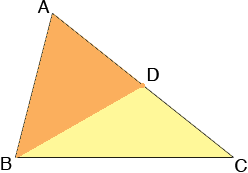
The point here is that no matter what triangle you choose with side AB I can always construct a triangle with side AB that has a smaller perimeter than yours. Thus it's not possible to choose a third point that results in the smallest possible perimeter.
Penny
RS wrote back
Thanks very much. Perhaps I did not make phrase my question correctly. With two points fixed and the third point variable but along a straight line, then which is the smallest triangle. Please see attached diagram.
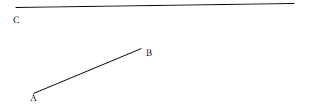
Regards
RS
Hi,
You drew the line as if it is horizontal but I don't want to make that assumption. Here is my diagram. I called the line L.
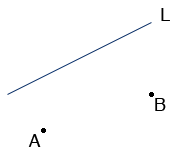
Reflect the point B in the line L to obtain a new point B'. Join A and B'. Let K be the point where this line meets L.
Claim: The triangle ABK has the least perimeter of any triangle ABX where X is on L.
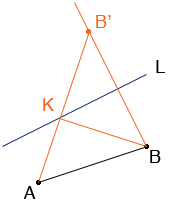
Since |KB| = |KB'| the perimeter of ABK is |AB| + |AB'|. If X is any other point on L then |XB| = |XB'| and the perimeter of ABX is |AB| + |AX| + |XB'|.

But |AX| + |XB'| > |AB'|.
We are not sure what you are trying to do but if you are trying to construct the point K here is one procedure.
Put a coordinate system on the plane. Let A = (a1, a2), B = (b1, b2) and L be the line y = mx + b.
- Subtract b from all the y-coordinates. This moves the line to y = mx which passes through the origin.
- Rotate the diagram so that the line L lies along the x-axis. The angle between the x-axis and L is tan(m) so rotate through an angle of - arctan(m). This rotation can be accomplished by multiplication by the matrix
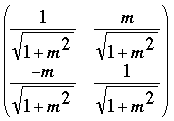 Let NA and NB be the new positions of A and B after subtracting b from the y-components and rotation by the matrix.
Let NA and NB be the new positions of A and B after subtracting b from the y-components and rotation by the matrix.
- Let NB have coordinates (nb1, nb2). Reflect NB through the x-axis to the point NB' (nb1, -nb2).
- Rotate the point NB' through the angle arctan(m). This can be accomplished by multiplication by the matrix
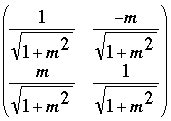 Finally add b to the y-coordinate of the rotated point and the resulting point is B'.
Finally add b to the y-coordinate of the rotated point and the resulting point is B'.
All that remains is to write the equation of the line through A and B' and find its intersection K with the line L.
Chris and Penny
 |
||
Math Central is supported by the University of Regina and The Pacific Institute for the Mathematical Sciences.